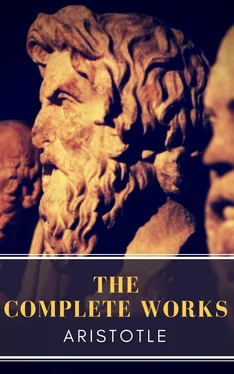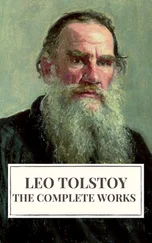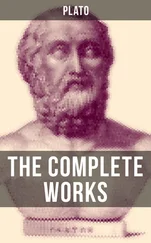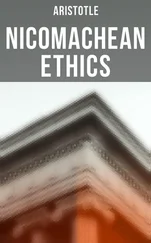Aristotle Aristotle - Aristotle - The Complete Works
Здесь есть возможность читать онлайн «Aristotle Aristotle - Aristotle - The Complete Works» — ознакомительный отрывок электронной книги совершенно бесплатно, а после прочтения отрывка купить полную версию. В некоторых случаях можно слушать аудио, скачать через торрент в формате fb2 и присутствует краткое содержание. Жанр: unrecognised, на английском языке. Описание произведения, (предисловие) а так же отзывы посетителей доступны на портале библиотеки ЛибКат.
- Название:Aristotle: The Complete Works
- Автор:
- Жанр:
- Год:неизвестен
- ISBN:нет данных
- Рейтинг книги:3 / 5. Голосов: 1
-
Избранное:Добавить в избранное
- Отзывы:
-
Ваша оценка:
- 60
- 1
- 2
- 3
- 4
- 5
Aristotle: The Complete Works: краткое содержание, описание и аннотация
Предлагаем к чтению аннотацию, описание, краткое содержание или предисловие (зависит от того, что написал сам автор книги «Aristotle: The Complete Works»). Если вы не нашли необходимую информацию о книге — напишите в комментариях, мы постараемся отыскать её.
This edition has been professionally formatted and contains several tables of contents. The first table of contents (at the very beginning of the ebook) lists the titles of all novels included in this volume. By clicking on one of those titles you will be redirected to the beginning of that work, where you'll find a new TOC that lists all the chapters and sub-chapters of that specific work.
Aristotle: The Complete Works — читать онлайн ознакомительный отрывок
Ниже представлен текст книги, разбитый по страницам. Система сохранения места последней прочитанной страницы, позволяет с удобством читать онлайн бесплатно книгу «Aristotle: The Complete Works», без необходимости каждый раз заново искать на чём Вы остановились. Поставьте закладку, и сможете в любой момент перейти на страницу, на которой закончили чтение.
Интервал:
Закладка:
9
Now while some things have a cause distinct from themselves, others have not. Hence it is evident that there are essential natures which are immediate, that is are basic premisses; and of these not only that they are but also what they are must be assumed or revealed in some other way. This too is the actual procedure of the arithmetician, who assumes both the nature and the existence of unit. On the other hand, it is possible (in the manner explained) to exhibit through demonstration the essential nature of things which have a ‘middle’, i.e. a cause of their substantial being other than that being itself; but we do not thereby demonstrate it.
10
Since definition is said to be the statement of a thing’s nature, obviously one kind of definition will be a statement of the meaning of the name, or of an equivalent nominal formula. A definition in this sense tells you, e.g. the meaning of the phrase ‘triangular character’. When we are aware that triangle exists, we inquire the reason why it exists. But it is difficult thus to learn the definition of things the existence of which we do not genuinely know-the cause of this difficulty being, as we said before, that we only know accidentally whether or not the thing exists. Moreover, a statement may be a unity in either of two ways, by conjunction, like the Iliad, or because it exhibits a single predicate as inhering not accidentally in a single subject.
That then is one way of defining definition. Another kind of definition is a formula exhibiting the cause of a thing’s existence. Thus the former signifies without proving, but the latter will clearly be a quasi-demonstration of essential nature, differing from demonstration in the arrangement of its terms. For there is a difference between stating why it thunders, and stating what is the essential nature of thunder; since the first statement will be ‘Because fire is quenched in the clouds’, while the statement of what the nature of thunder is will be ‘The noise of fire being quenched in the clouds’. Thus the same statement takes a different form: in one form it is continuous demonstration, in the other definition. Again, thunder can be defined as noise in the clouds, which is the conclusion of the demonstration embodying essential nature. On the other hand the definition of immediates is an indemonstrable positing of essential nature.
We conclude then that definition is (a) an indemonstrable statement of essential nature, or (b) a syllogism of essential nature differing from demonstration in grammatical form, or (c) the conclusion of a demonstration giving essential nature.
Our discussion has therefore made plain (1) in what sense and of what things the essential nature is demonstrable, and in what sense and of what things it is not; (2) what are the various meanings of the term definition, and in what sense and of what things it proves the essential nature, and in what sense and of what things it does not; (3) what is the relation of definition to demonstration, and how far the same thing is both definable and demonstrable and how far it is not.
11
We think we have scientific knowledge when we know the cause, and there are four causes: (1) the definable form, (2) an antecedent which necessitates a consequent, (3) the efficient cause, (4) the final cause. Hence each of these can be the middle term of a proof, for (a) though the inference from antecedent to necessary consequent does not hold if only one premiss is assumed-two is the minimum-still when there are two it holds on condition that they have a single common middle term. So it is from the assumption of this single middle term that the conclusion follows necessarily. The following example will also show this. Why is the angle in a semicircle a right angle?-or from what assumption does it follow that it is a right angle? Thus, let A be right angle, B the half of two right angles, C the angle in a semicircle. Then B is the cause in virtue of which A, right angle, is attributable to C, the angle in a semicircle, since B=A and the other, viz. C,=B, for C is half of two right angles. Therefore it is the assumption of B, the half of two right angles, from which it follows that A is attributable to C, i.e. that the angle in a semicircle is a right angle. Moreover, B is identical with (b) the defining form of A, since it is what A’s definition signifies. Moreover, the formal cause has already been shown to be the middle. (c) ‘Why did the Athenians become involved in the Persian war?’ means ‘What cause originated the waging of war against the Athenians?’ and the answer is, ‘Because they raided Sardis with the Eretrians’, since this originated the war. Let A be war, B unprovoked raiding, C the Athenians. Then B, unprovoked raiding, is true of C, the Athenians, and A is true of B, since men make war on the unjust aggressor. So A, having war waged upon them, is true of B, the initial aggressors, and B is true of C, the Athenians, who were the aggressors. Hence here too the cause-in this case the efficient cause-is the middle term. (d) This is no less true where the cause is the final cause. E.g. why does one take a walk after supper? For the sake of one’s health. Why does a house exist? For the preservation of one’s goods. The end in view is in the one case health, in the other preservation. To ask the reason why one must walk after supper is precisely to ask to what end one must do it. Let C be walking after supper, B the non-regurgitation of food, A health. Then let walking after supper possess the property of preventing food from rising to the orifice of the stomach, and let this condition be healthy; since it seems that B, the non-regurgitation of food, is attributable to C, taking a walk, and that A, health, is attributable to B. What, then, is the cause through which A, the final cause, inheres in C? It is B, the non-regurgitation of food; but B is a kind of definition of A, for A will be explained by it. Why is B the cause of A’s belonging to C? Because to be in a condition such as B is to be in health. The definitions must be transposed, and then the detail will become clearer. Incidentally, here the order of coming to be is the reverse of what it is in proof through the efficient cause: in the efficient order the middle term must come to be first, whereas in the teleological order the minor, C, must first take place, and the end in view comes last in time.
The same thing may exist for an end and be necessitated as well. For example, light shines through a lantern (1) because that which consists of relatively small particles necessarily passes through pores larger than those particles-assuming that light does issue by penetrationand (2) for an end, namely to save us from stumbling. If then, a thing can exist through two causes, can it come to be through two causes-as for instance if thunder be a hiss and a roar necessarily produced by the quenching of fire, and also designed, as the Pythagoreans say, for a threat to terrify those that lie in Tartarus? Indeed, there are very many such cases, mostly among the processes and products of the natural world; for nature, in different senses of the term ‘nature’, produces now for an end, now by necessity.
Necessity too is of two kinds. It may work in accordance with a thing’s natural tendency, or by constraint and in opposition to it; as, for instance, by necessity a stone is borne both upwards and downwards, but not by the same necessity.
Of the products of man’s intelligence some are never due to chance or necessity but always to an end, as for example a house or a statue; others, such as health or safety, may result from chance as well.
It is mostly in cases where the issue is indeterminate (though only where the production does not originate in chance, and the end is consequently good), that a result is due to an end, and this is true alike in nature or in art. By chance, on the other hand, nothing comes to be for an end.
Читать дальшеИнтервал:
Закладка:
Похожие книги на «Aristotle: The Complete Works»
Представляем Вашему вниманию похожие книги на «Aristotle: The Complete Works» списком для выбора. Мы отобрали схожую по названию и смыслу литературу в надежде предоставить читателям больше вариантов отыскать новые, интересные, ещё непрочитанные произведения.
Обсуждение, отзывы о книге «Aristotle: The Complete Works» и просто собственные мнения читателей. Оставьте ваши комментарии, напишите, что Вы думаете о произведении, его смысле или главных героях. Укажите что конкретно понравилось, а что нет, и почему Вы так считаете.












